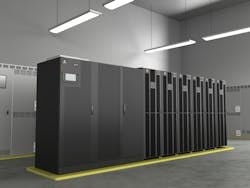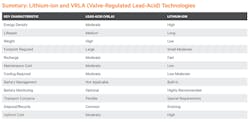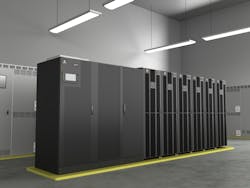Evaluating the Safety of Lithium-Ion Batteries in Critical Facilities
While every data center operator is eager to optimize space, efficiency, and operating resources, none are willing to sacrifice safety to make these improvements. Although most operators still choose lead acid batteries in data center applications today, interest in (and adoption of) lithium ion in the data center and other critical facilities appears to be building momentum.
The main driver of interest is the extended service life lithium-ion batteries deliver. With a service life of 10 to 15 years in critical facility applications, using lithium-ion batteries can mean eliminating anywhere from two to four replacements that would be required with lead acid batteries over the same period. Fewer replacements means lower total cost of ownership as well as the benefit of fewer technicians going into and out of security-conscious data centers.
The business case is further enhanced by the environmental and physical characteristics of some lithium-ion alternatives. Lithium-ion batteries can safely operate at temperatures 7°F to 9°F higher than lead acid batteries, significantly reducing the demand for dedicated cooling in battery rooms. Plus, they have density and weight advantages that are important in some applications.
Although difficult to quantify at this stage of their development, lithium-ion batteries might also contribute to enhanced data center reliability. Batteries are the acknowledged weak link in the critical power system —one of the main reasons of which is the tendency for lead acid battery performance to decline sharply in a short period of time. Lithium-ion batteries generally degrade more gradually and predictably.
In addition, the sophisticated battery management systems (BMSs) integrated into industrial lithium-ion batteries provide users and service providers with access to battery operating data that can be used to maximize life and predict failure.
The value proposition for lithium-ion batteries in the data center is strong and will likely get stronger as more production capacity comes online, and the batteries demonstrate their value over more operating hours. Still, some data center operators remain concerned about the safety of the technology and are unsure how to comply with current codes and standards.
Designing for safety
Safety concerns with lithium-ion batteries are often the result of well-reported incidents of batteries combusting in consumer devices or following electric vehicle (EV) crashes. In each case, this is more a problem of perception than reality.
Industrial lithium-ion batteries are different in design and construction than their consumer counterparts, which prioritize shrinking the battery into the smallest possible space. By contrast, industrial lithium-ion batteries feature multilayered internal safety construction containing far more robust cell designs. Safety fuses, overcharge protection, thermal management measures and redundant control mechanisms have all been implemented to mitigate the risk of thermal runaway. The BMS system mentioned previously actively manages system safety, including automatically initiating a fail-safe shutdown in the event that operating conditions go outside the normal range — long before a serious safety incident would occur. If there is an issue, the BMS controls a safety breaker that is independent of the fuses and other layers of electrical protection. If the BMS senses that a safety risk could develop, it disconnects the battery from the power system, regardless of the operating state at that moment.
Industrial lithium-ion batteries have also benefitted from advances in design driven by the electrical vehicle (EV) manufacturers. An in-depth study by Battelle for the National Highway Safety Administration found that, "The propensity and severity of fires from ... lithium-ion battery systems are anticipated to be somewhat comparable to or perhaps slightly less than those for gasoline or diesel vehicular fuels."
Still, the EV industry is continually pushing battery manufacturers to improve the abuse tolerance of batteries, which are subject to much harsher conditions than UPS batteries because of the mobile nature of the application. While the lithium-ion batteries used with UPS systems are not subject to the same hazards as those in an EV following a crash, the design enhancements that result from these efforts are often applied to lithium-ion batteries in other industrial applications, further enhancing their safety and abuse tolerance.
Manufacturing for safety
Lithium-ion batteries used in UPS applications have also benefitted from safety advances in manufacturing that resulted from an analysis of the early failures that occurred in consumer devices. What battery manufacturers found is that the causes were related more to manufacturing processes than design flaws. Specifically, metal debris left in the housing during manufacturing created shorts that resulted in overheating (which would have been detected by the BMS in an industrial system).
Leading manufacturers now use highly developed quality control processes to address these risks. Companies that integrate industrial lithium-ion batteries into their systems, such as UPS and EV manufacturers, evaluate battery manufacturers based on these quality processes. Battery manufacturers that can meet the demanding requirements of these technology companies have demonstrated their commitment to the quality manufacturing processes that correlate with safe operation.
Evolving regulatory environment
While concerns about industrial lithium-ion battery safety are mostly a problem of perception today, there are some valid concerns regarding codes — although once understood, these are not difficult to navigate.
In 2018, the National Fire Protection Association (NFPA) released code revisions that provide direction on the use of lithium-ion batteries in UPS applications. The code covers a range of areas such as the battery enclosure, the battery management system, and battery location. This was an important first step in clarifying the issues around lithium-ion deployment in data centers, but the NFPA code has also created some uncertainty among potential users.
That’s because the NFPA is also developing a supplemental standard to support the top-line code and this supplemental standard has yet to be released. Plus, state regulators determine when to adopt the revised national code and it typically takes years for states to complete that process. To date, only California has adopted the national code, and it is hoped that the pending supplemental standard will be issued before other states adopt the recent national code revisions
Of particular concern to potential users is the new national code’s requirement that lithium-ion battery cabinets that have not yet passed new testing related to the potential for thermal runaway must be spaced at least three feet apart to eliminate risk. This spacing requirement makes the application of lithium-ion batteries impractical in most data centers, and some operators are unsure how local officials will interpret the code.
However, while code development and adoption are moving more slowly than some would like, advances in testing can compensate for the current gaps. For large lithium-ion batteries used with UPS systems, UL has developed standard testing and qualification processes that ensure safety. The individual battery cells are addressed under UL 1642, Standard for Lithium Batteries, which includes abuse tolerance tests. UL 1973, Standard for Batteries for Use in Stationary, Vehicle Auxiliary Power and Light Electric Rail (LER) Applications, covers the battery system as a whole and outlines a series of safety tests on issues such as overcharging, short-circuit exposure and high temperature. This has resulted in the ready availability of UL-tested lithium-ion battery systems for data centers.
While the regulatory environment is still evolving, advances in design, manufacturing and testing of large lithium-ion batteries have addressed previous safety concerns and allow data center operators to move forward with this technology with confidence. A growing number of operators are finding that working with an experienced partner who understands the current code and local preferences and can specify certified battery systems from quality manufacturers is the key to success. Through these partnerships, they can leverage the multiple benefits of lithium-ion batteries in critical facility applications without waiting on further deliberation among regulatory agencies.
Kessen is the vice president of energy storage at Vertiv, headquartered in Columbus, Ohio.
About the Author
Jeff Kessen
Vice President of Energy Storage
Kessen is the vice president of energy storage at Vertiv, headquartered in Columbus, Ohio.


